Emergence of the Online-Merge-Offline (OMO) Learning Wave in the Post-COVID-19 Era: A Pilot Study
Abstract
1. Introduction
1.1. Education during the Post-COVID-19 Pandemic
1.2. Research Motivation and Objectives
2. Study Context: OMO Learning
3. Method
3.1. Theoretical Framework and Research Questions
3.2. Participants and Procedure
3.3. Data Analysis
4. Results
4.1. How Is the Learning Space Designed to Have a Successful OMO Teaching and Learning Experience?
4.1.1. Infrastructure
“Offline facilities give people a sense of advancement. Freely movable chairs, large screens that can be directly projected on all sides, free-speaking classrooms, online teaching, multiple teachers, streamlined content, and different teaching methods, are features of an OMO class. It made me feel fresh and interested while learning a lot of knowledge.”
“The equipment in OMO classroom is much more than traditional chalks and a blackboard. We use big screens in class with advanced technologies [to] teach in real-time both group[s] of students (online and offline).”
4.1.2. Skills
“In the classroom, teachers share files through DingTalk, and we view those learning materials in real-time on our mobile phones. In addition, I like commenting on my classmates’ post from my mobile phone. It keeps me updated.”
“In the OMO teaching mode, teachers are required to use advanced teaching software to upload courseware and interact with it in real-time using hand gestures, hence we must be familiar with the tool and platform.”
4.2. What Are the Functions of Technology in the OMO Teaching and Learning Experience?
4.2.1. Supporting Health and Safety
“OMO modality is equipped with technologies that enable studying outside the physical classroom. I feel more secured and safer using OMO especially when there is a pandemic going on. I also don’t have to worry that I might get left behind if I get sick and am not be able to go to school, since now I can join my classmates from home.”
4.2.2. Supporting Connectivity
“To expand the influence of excellent teachers, the online-merge-offline model has been promoted, and many schools are also advancing OMO recently. Let an excellent teacher synchronize his or her courses to multiple classrooms. This modality hence expands the influence of high-quality courses and teachers as well as strengthens the network among schools.”
4.2.3. Offering Openness and Flexibility
“I can have more practical activities, which are very innovative and interactive, as well as work in groups more freely.”
4.2.4. Facilitating Communication
“It is not just simply listening to the teacher, but there are actual facilities and technologies available on-site, so that we can quickly respond to teachers and communicate with classmates offline and online.”
4.3. What Are the Perceptions of Teachers and Students towards Pedagogy in the Context of OMO Teaching and Learning?
“… (my learning efficiency and abilities are) improved, I think this learning mode is definitely more impressive and persuasive than memorizing theoretical knowledge, so it is improved through actual operation.”
“It was difficult sometimes to tell if the answer box in the picture is something that I can control. Also, the teacher is facing the camera. There is no sense of interaction sometimes.”
5. Discussion
5.1. Hybrid Infrastructure
5.2. Extended Learning Spaces
5.3. Open and Flexible Educational Practices
5.4. Suitable and Interactive (Open) Resources
5.5. Comprehensive Competency of Teachers and Students
6. Conclusions
Author Contributions
Funding
Institutional Review Board Statement
Informed Consent Statement
Data Availability Statement
Acknowledgments
Conflicts of Interest
References
- UNICEF. Keeping the World’s Children Learning through COVID-19. Available online: https://www.unicef.org/coronavirus/keeping-worlds-children-learning-through-covid-19 (accessed on 20 April 2020).
- UNESCO. UNESCO Launches Global Consultation on the Futures of Education Initiative. Available online: https://en.unesco.org/futuresofeducation/initiative (accessed on 12 January 2021).
- UNICEF. Coronavirus Disease (COVID-19) Information Centre. Available online: https://www.unicef.org/coronavirus/covid-19 (accessed on 20 January 2021).
- Kanwar, A.; Daniel, J. Report to Commonwealth Education Ministers: From Response to Resilience. Available online: http://oasis.col.org/handle/11599/3592 (accessed on 23 June 2020).
- Reliefweb. Hundreds of Millions of Students Now Learning from Home after Coronavirus Crisis Shuts Their Schools. Available online: https://reliefweb.int/report/world/hundreds-millions-students-now-learning-home-after-coronavirus-crisis-shuts-their (accessed on 13 January 2021).
- Bergdahl, N.; Nouri, J. Covid-19 and Crisis-Prompted Distance Education in Sweden. Technol. Knowl. Learn. 2020, 1–17. [Google Scholar] [CrossRef]
- Hodges, C. The Difference between Emergency Remote Teaching and Online Learning. Available online: https://er.educause.edu/articles/2020/3/the-difference-between-emergency-remote-teaching-and-online-learning (accessed on 6 February 2021).
- Van der Spoel, I.; Noroozi, O.; Schuurink, E.; van Ginkel, S. Teachers’ online teaching expectations and experiences during the Covid19-pandemic in the Netherlands. Eur. J. Teach. Educ. 2020, 43, 623–638. [Google Scholar] [CrossRef]
- La Velle, L.; Newman, S.; Montgomery, C.; Hyatt, D. Initial teacher education in England and the Covid-19 pandemic: Challenges and opportunities. J. Educ. Teach. 2020, 46, 596–608. [Google Scholar] [CrossRef]
- Artacho, E.G.; Martínez, T.S.; Martín, J.L.O.; Marín, J.A.M.; García, G.G. Teacher Training in Lifelong Learning—The Importance of Digital Competence in the Encouragement of Teaching Innovation. Sustain. J. Rec. 2020, 12, 2852. [Google Scholar] [CrossRef]
- Moreno-Guerrero, A.J.; Miaja-Chippirraz, N.; Bueno-Pedrero, A.; Borrego-Otero, L. The Information and Information Literacy Area of the Digital Teaching Competence. Rev. Electrón. Educ. 2020, 24, 521–536. [Google Scholar]
- Tømte, C.; Enochsson, A.B.; Buskqvist, U.; Kårstein, A. Educating Online Student Teachers to Master Professional Digital Competence: The TPACK-framework Goes Online. Comput. Educ. 2015, 84, 26–35. [Google Scholar] [CrossRef]
- The Washington Post, Reopened Schools in Europe and Asia Have Largely Avoided Coronavirus Outbreaks. They Have Lessons for the U.S. Available online: https://www.washingtonpost.com/world/europe/schools-reopening-coronavirus/2020/07/10/865fb3e6-c122-11ea-8908-68a2b9eae9e0_story.html (accessed on 11 July 2020).
- Civil Aviation Administration of China, Preventing Spread of Coronavirus Disease 2019 (COVID-19) Guideline for Airlines. Available online: http://www.caac.gov.cn/en/XWZX/202006/W020200626738640795089.pdf (accessed on 21 January 2021).
- Centers for Disease Control and Prevention, COVID-19 Travel Recommendations by Destination. Available online: https://www.cdc.gov/coronavirus/2019-ncov/travelers/map-and-travel-notices.html (accessed on 19 February 2021).
- Xiao, C.; Li, Y. Analysis on the Influence of the Epidemic on the Education in China. In Proceedings of the 2020 International Conference on Big Data and Informatization Education (ICBDIE), Shenzhen, China, 4–6 December 2020. [Google Scholar]
- The East Africa, Kenya Schools to Reopen in January. Available online: https://www.theeastafrican.co.ke/tea/news/east-africa/kenyan-schools-to-reopen-in-january-3023514 (accessed on 17 December 2020).
- Indian Express, How and When Will Schools Reopen. Available online: https://indianexpress.com/article/explained/how-and-when-will-schools-reopen-what-will-change-for-students-6704619/ (accessed on 15 February 2021).
- Guthrie, B.L.; Tordoff, D.M.; Meisner, J.; Tolentino, L.; Jiang, W.; Fuller, S.; Green, D.; Louden, D.; Ross, J.M. Summary of School Re-Opening Models and Implementation Approaches during the COVID 19 Pandemic. Available online: https://www.doh.wa.gov/Portals/1/Documents/1600/coronavirus/20200706-SchoolsSummary.pdf (accessed on 22 January 2021).
- The University of Edinburgh, Information about Semester 2. Available online: https://www.ed.ac.uk/news/covid-19/current-students/semester-2 (accessed on 17 February 2021).
- Fordham University. Class Held Fully Online. Available online: https://www.fordham.edu/info/21360/academic_records_registrar/11825/courses_held_fully_online (accessed on 10 January 2021).
- New York University. A Look Ahead to Spring 2021 and Important Proposed Changes to the Academic Calendar. Available online: https://www.nyu.edu/about/leadership-university-administration/office-of-the-president/communications/a-look-ahead-to-spring2021-and-important-proposed-changes-to-the-academic-calendar.html (accessed on 20 October 2020).
- Orellana, A. Class size and interaction in online courses. In The Perfect Online Course: Best Practices for Designing and Teaching, North Carolina; IAP: Charlotte, NC, USA, 2009; pp. 117–135. [Google Scholar]
- Caulkins, J.; Grass, D.; Feichtinger, G.; Hartl, R.; Kort, P.M.; Prskawetz, A.; Seidl, A.; Wrzaczek, S. How long should the COVID-19 lockdown continue? PLoS ONE 2020, 15, e0243413. [Google Scholar] [CrossRef] [PubMed]
- Petraglia, J. The real world on a short leash: The (mis) application of constructivism to the design of educational technology. Educ. Technol. Res. Dev. 1998, 46, 53–65. [Google Scholar] [CrossRef]
- Herrington, J.; Reeves, T.C.; Oliver, R. A Guide to Authentic e-Learning; Routledge: New York, NY, USA, 2010. [Google Scholar]
- Ertmer, P.; Ottenbreit-Leftwich, A.T. Teacher Technology Change: How Knowledge, Confidence, Beliefs and Culture Intersect. J. Res. Technol. Educ. 2010, 42, 255–284. [Google Scholar] [CrossRef]
- Romeo, G.; Lloyd, M.; Downes, T. Teaching Teachers for the Future (TTF): Building the ICT in education capacity of the next generation of teachers in Australia. Australas. J. Educ. Technol. 2012, 28, 949–964. [Google Scholar] [CrossRef]
- Wiley, D.; Hilton, J.L., III. Defining OER-Enabled Pedagogy. Int. Rev. Res. Open Distrib. Learn. 2018, 19. [Google Scholar] [CrossRef]
- Mintz, S. Making Online Learning Active. Available online: https://www.insidehighered.com/blogs/higher-ed-gamma/making-online-learning-active (accessed on 6 July 2020).
- Toor, R. Turns Out You Can Build Community in a Zoom Classroom, The Chronicle of Higher Education. Available online: https://www.chronicle.com/article/Turns-Out-You-Can-Build/249038 (accessed on 23 June 2020).
- Veletsianos, G. The 7 Elements of a Good Online Course, The Conversation. Available online: https://theconversation.com/the-7-elements-of-a-good-online-course-139736 (accessed on 21 January 2021).
- Filho, W.L.; Price, E.; Wall, T.; Shiel, C.; Azeiteiro, U.M.; Mifsud, M.; Brandli, L.; Farinha, C.S.; Caeiro, S.; Salvia, A.L.; et al. COVID-19: The impact of a global crisis on sustainable development teaching. Environ. Dev. Sustain. 2021, 1–22. [Google Scholar]
- Wolff, L.-A. Sustainability Education in Risks and Crises: Lessons from Covid-19. Sustain. J. Rec. 2020, 12, 5205. [Google Scholar] [CrossRef]
- McCowan, T. Universities and the post-2015 development agenda: An analytical framework. High. Educ. 2016, 72, 505–523. [Google Scholar] [CrossRef]
- Karatzoglou, B. An in-depth literature review of the evolving roles and contributions of universities to education for sus-tainable development. J. Clean. Prod. 2013, 49, 44–53. [Google Scholar] [CrossRef]
- Tsai, T.-M.; Wang, W.-N.; Lin, Y.-T.; Choub, S.-C. An O2O Commerce Service Framework and its Effectiveness Analysis with Application to Proximity Commerce. Procedia Manuf. 2015, 3, 3498–3505. [Google Scholar] [CrossRef]
- Hilliard, J.; Kear, K.; Donelan, H.; Heaney, C. Students’ experiences of anxiety in an assessed, online, collaborative project. Comput. Educ. 2020, 143, 103675. [Google Scholar] [CrossRef]
- Wang, C.; Fang, T.; Gu, Y. Learning performance and behavioral patterns of online collaborative learning: Impact of cog-nitive load and affordances of different multimedia. Comput. Educ. 2020, 143, 103683. [Google Scholar] [CrossRef]
- Xiao, J.; Sun-Lin, H.-Z.; Cheng, H.-C. A framework of online-merge-offline (OMO) classroom for open education. Asian Assoc. Open Univ. J. 2019, 14, 134–146. [Google Scholar] [CrossRef]
- Radcliffe, D. A Pedagogy-Space-Technology (PST) Framework for Designing and Evaluating Learning Places. In Proceedings of the Next Generation Learning Spaces 2008 Colloquium; University of Queensland: Brisbane, Australia, 2009; pp. 11–16. [Google Scholar]
- Ng, J. Innovating with Pedagogy-Space-Technology (PST) Framework: The Online Moot Court. Learn. Communities Int. J. Learn. Soc. Context. 2015, 18, 52–65. [Google Scholar] [CrossRef]
- Pan, X.; Zhu, L. An E-learning Space for the Economics Experimental Teaching Based on Pedagogy-Space-Technology Framework. In Proceedings of the 2020 International Conference on Advanced Education, Management and Information Technology (AEMIT 2020), Shanghai, China, 22–23 March 2020. [Google Scholar]
- Hua, Z.; Ma, Z.; Ding, Y. A research and case study of purpose oriented PST framework for redesigning learning spaces. China Educ. Technol. 2017, 361, 76–81. [Google Scholar]
- Tlili, A.; Essalmi, F.; Jemni, M. Improving learning computer architecture through an educational mobile game. Smart Learn. Environ. 2016, 3. [Google Scholar] [CrossRef]
- British Educational Research Association. Available online: https://www.bera.ac.uk/researchers-resources/publications/ethical-guidelines-for-educational-research-2011 (accessed on 31 July 2011).
- Flick, U. An Introduction to Qualitative Research, 4th ed.; Sage: London, UK, 2009. [Google Scholar]
- Erlingsson, C.; Brysiewicz, P. A hands-on guide to doing content analysis. J. Emerg. Med. 2017, 7, 93–99. [Google Scholar] [CrossRef]
- Richardson, J.C.; Koehler, A.A.; Besser, E.D.; Caskurlu, S.; Lim, J.; Mueller, C.M. Conceptualizing and investigating instructor presence in online learning environments. Int. Rev. Res. Open Distrib. Learn. 2015, 16. [Google Scholar] [CrossRef]
- Creswell, J.W. Research Design: Qualitative, Quantitative, and Mixed Methods Approaches, 4th ed.; Sage: Thousand Oaks, CA, USA, 2014; pp. 203–204. [Google Scholar]
- Yin, R.K. Case Study Research: Design and Methods, 4th ed.; Sage: Riverside, CA, USA, 2009. [Google Scholar]
- Baxter, P.; Jack, S. Qualitative case study methodology: Study design and implementation for novice researchers. Qual. Rep. 2008, 13, 544–559. [Google Scholar]
- Olapiriyakul, K.; Scher, J.M. A guide to establishing hybrid learning courses: Employing information technology to create a new learning experience, and a case study. Internet High. Educ. 2006, 9, 287–301. [Google Scholar] [CrossRef]
- Lahti University. International CEPHEI Project Aims to Build an e-Learning Platform that Follows Progress and Tests Knowledge. Available online: https://www.lut.fi/web/en/news/-/asset_publisher/lGh4SAywhcPu/content/international-cephei-project- aims-to-build-an-e-learning-platform-that-follows-progress-and-tests-knowledge (accessed on 24 August 2018).
- James, N. Re: Learning Analytics as an Important Service in This New COVID and Mandatory e-Learning Situation. Available online: https://www.researchgate.net/post/Learning-Analytics-as-an-important-service-in-this-new-COVID-and-mandatory-e-learning-situation/5f7b01303e3e205531216d71/citation/download (accessed on 10 January 2021).
- Huang, R.; Liu, D.; Tlili, A.; Knyazeva, S.; Chang, T.W.; Zhang, X.; Burgos, D.; Jemni, M.; Zhang, M.; Zhuang, R.; et al. Guidance on Open Educational Practices during School Closures: Utilizing OER under COVID-19 Pandemic in Line with UNESCO OER Recommendation; Smart Learning Institute of Beijing Normal University: Beijing, China, 2020; Available online: https://educacion.udd.cl/ aprendizaje180/files/2020/12/UNESCO-IITE-Guidance-on-Open-Educational-Practices-during-School-Closures-2020.pdf (accessed on 24 January 2021).
- Huang, R.; Tlili, A.; Yang, J.; Chang, T. Handbook on Facilitating Flexible Learning during Educational Disruption: The Chinese Experience in Maintaining Undisrupted Learning in COVID-19 Outbreak; Smart Learning Institute of Beijing Normal University: Beijing, China, 2020; Available online: https://iite.unesco.org/wp-content/uploads/2020/03/Handbook-on-Facilitating-Flexible-Learning- in-COVID-19-Outbreak-SLIBNU-V1.2-20200315.pdf (accessed on 20 January 2021).
- Ryan, A.; Tilbury, D. Flexible Pedagogies: New Pedagogical Ideas, Higher Education Academy, November 2013. Available online: https://www.heacademy.ac.uk/sites/default/files/resources/npi_report.pdf (accessed on 13 January 2021).
- Zhang, X.; Tlili, A.; Huang, R.; Chang, T.; Burgos, D.; Yang, J.; Zhang, J. A Case Study of Applying Open Educational Practices in Higher Education during COVID-19: Impacts on Learning Motivation and Perceptions. Sustain. J. Rec. 2020, 12, 9129. [Google Scholar] [CrossRef]
- Goodyear, P.; Salmon, G.; Spector, J.M.; Steeples, C.; Tickner, S. Competences for online teaching: A special report. Educ. Technol. Res. Dev. 2001, 49, 65–72. [Google Scholar] [CrossRef]
- König, J.; Jäger-Biela, D.J.; Glutsch, N. Adapting to online teaching during COVID-19 school closure: Teacher education and teacher competence effects among early career teachers in Germany. Eur. J. Teach. Educ. 2020, 43, 608–622. [Google Scholar] [CrossRef]
- The European Commission’s Science and Knowledge Service. Available online: https://ec.europa.eu/jrc/en/digcompedu (accessed on 11 November 2020).
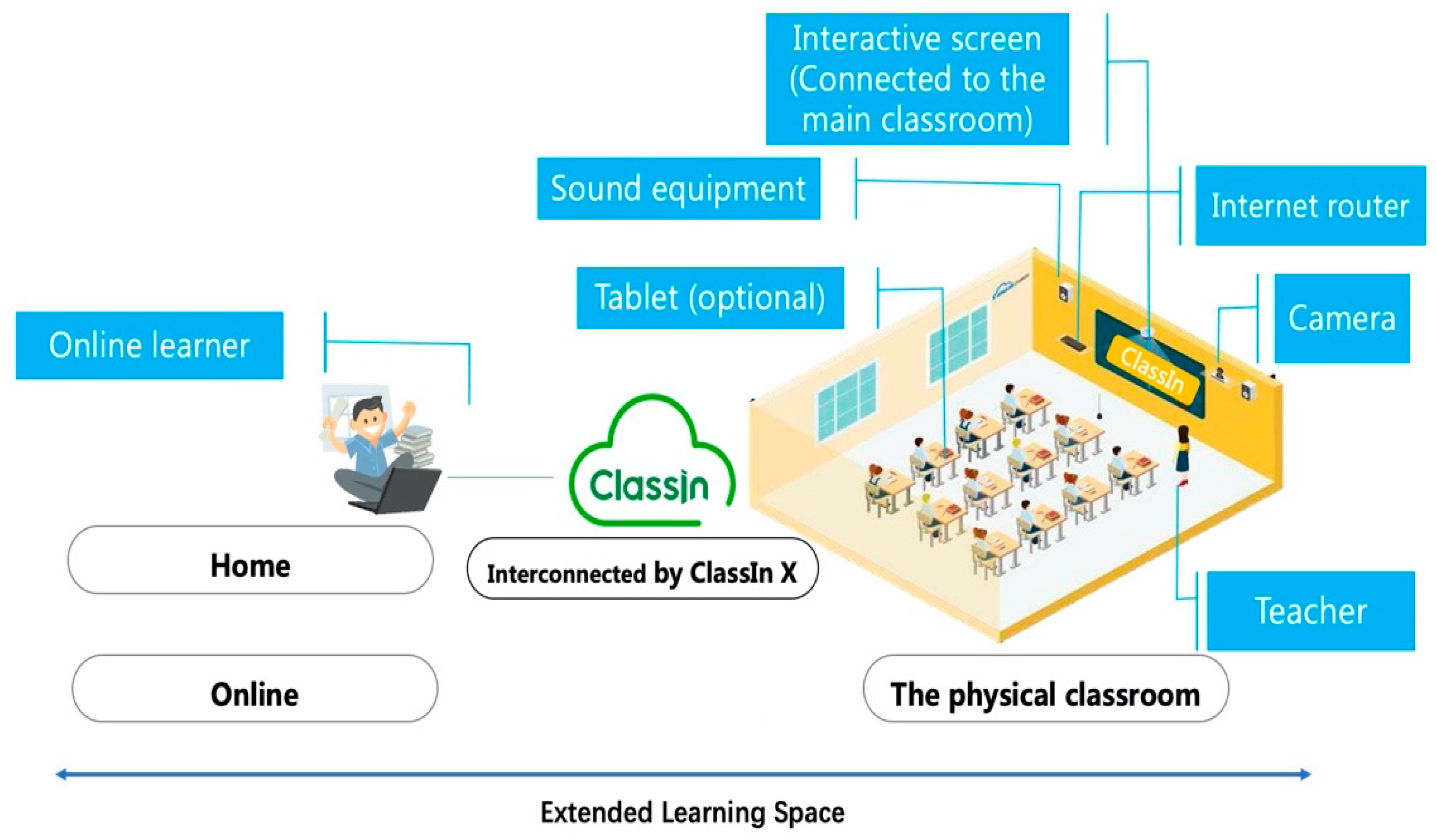
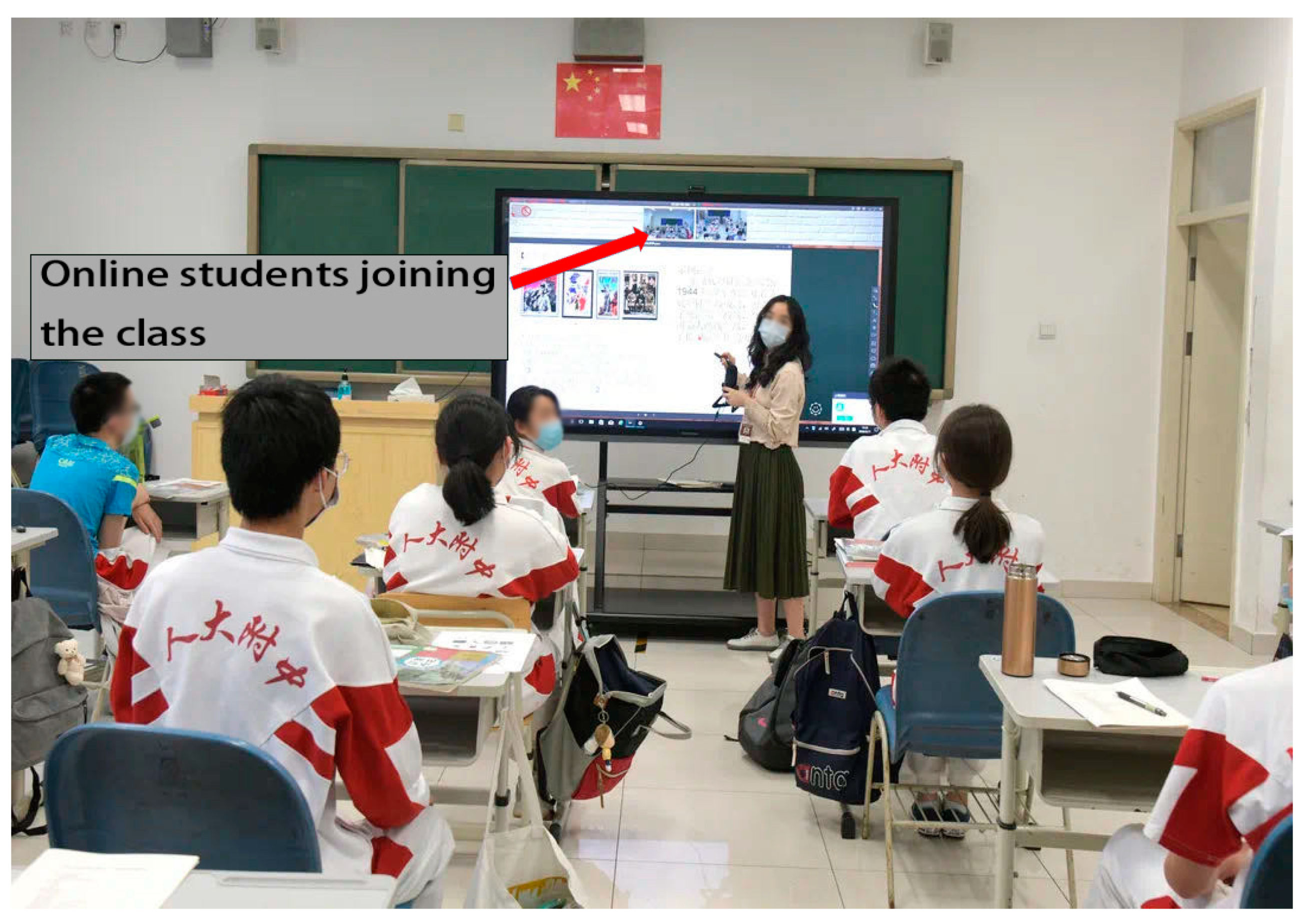
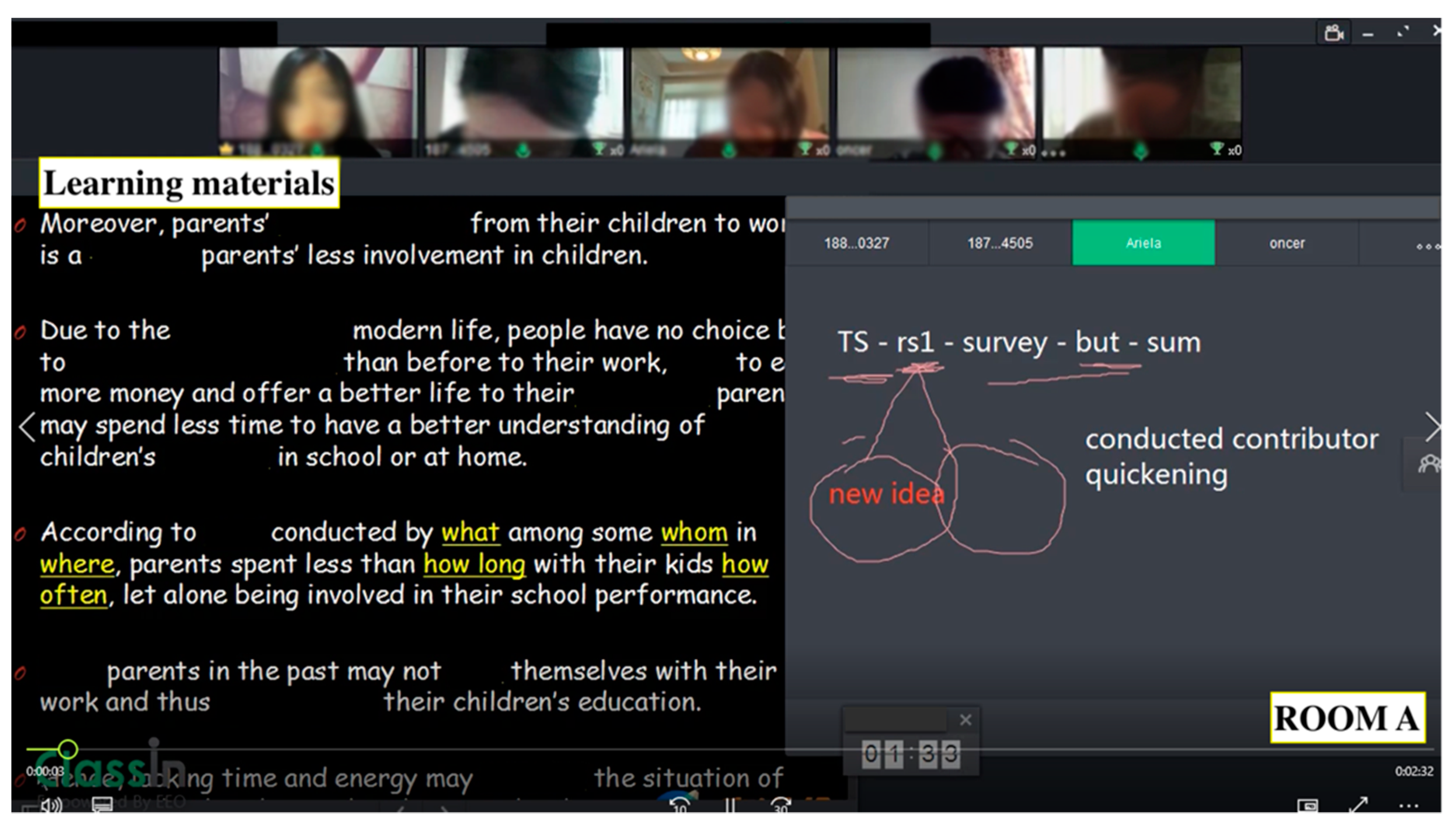
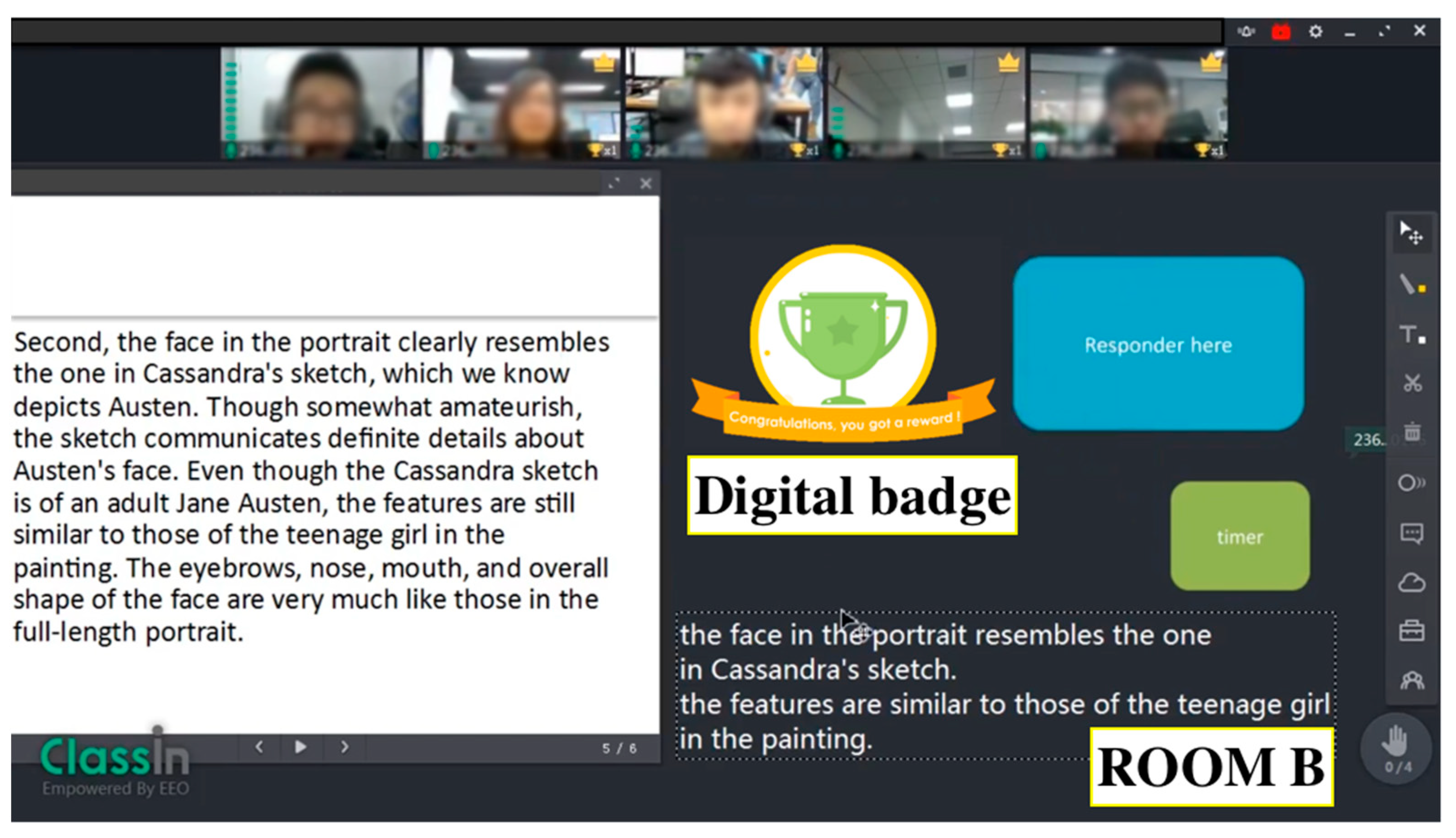
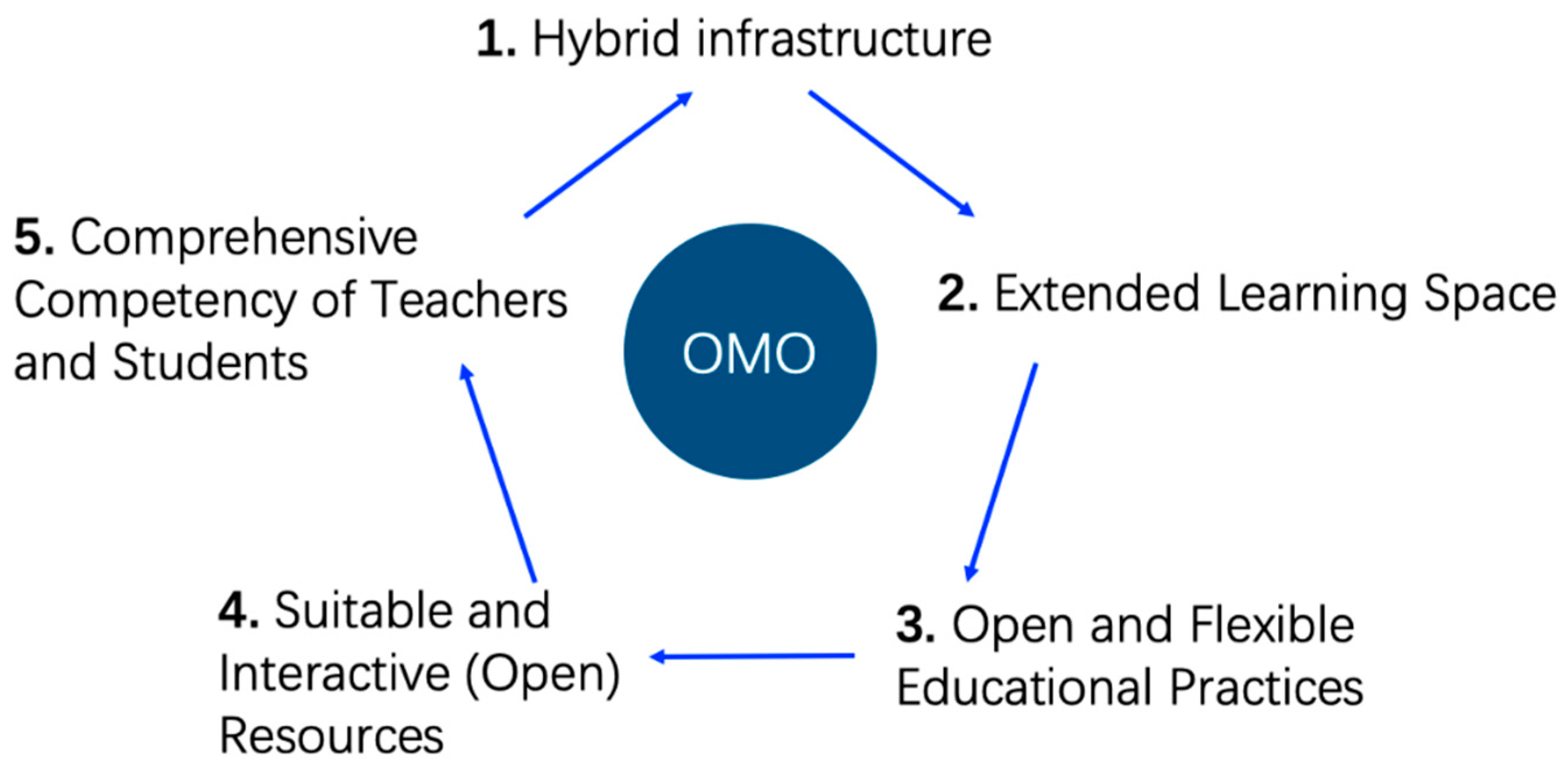
| Code | When to Use |
|---|---|
| OMO Space Design and Requirements | Use this code when the participants are talking about the space design and skills to have a successful OMO learning or teaching experience. |
| Functions of Technologies in OMO | Use this code when the participants are talking about the different functionalities of technologies in OMO learning. |
| Perceptions towards Pedagogies in OMO | Use this code when the participants are talking about their perceptions towards teaching/learning in OMO. |
| Themes | Percentage of the Students Mentioning Each Code | Percentage of the Teachers Mentioning Each Code |
|---|---|---|
| Infrastructure | 100% | 80% |
| ICT skill | 20% | 100% |
| Utilizing resources skill | 10% | 40% |
| Pedagogical skill | 0% | 100% |
| Functionality | Percentage of the Students Mentioning Each Code | Percentage of the Teachers Mentioning Each Code |
|---|---|---|
| Ensuring Health Safety | 5% | 10% |
| Supporting Connectivity | 30% | 80% |
| Offering Openness and Flexibility | 40% | 80% |
| Facilitating Communication | 40% | 100% |
| Perception | Percentage of the Students Mentioning Each Code | Percentage of the Teachers Mentioning Each Code |
|---|---|---|
| Positive | 100% | 20% |
| Reluctancy | 15% | 10% |
| Unfamiliarity | 40% | 20% |
Publisher’s Note: MDPI stays neutral with regard to jurisdictional claims in published maps and institutional affiliations. |
© 2021 by the authors. Licensee MDPI, Basel, Switzerland. This article is an open access article distributed under the terms and conditions of the Creative Commons Attribution (CC BY) license (http://creativecommons.org/licenses/by/4.0/).
Share and Cite
Huang, R.; Tlili, A.; Wang, H.; Shi, Y.; Bonk, C.J.; Yang, J.; Burgos, D. Emergence of the Online-Merge-Offline (OMO) Learning Wave in the Post-COVID-19 Era: A Pilot Study. Sustainability 2021, 13, 3512. https://doi.org/10.3390/su13063512
Huang R, Tlili A, Wang H, Shi Y, Bonk CJ, Yang J, Burgos D. Emergence of the Online-Merge-Offline (OMO) Learning Wave in the Post-COVID-19 Era: A Pilot Study. Sustainability. 2021; 13(6):3512. https://doi.org/10.3390/su13063512
Chicago/Turabian StyleHuang, Ronghuai, Ahmed Tlili, Huanhuan Wang, Yihong Shi, Curtis J. Bonk, Junfeng Yang, and Daniel Burgos. 2021. "Emergence of the Online-Merge-Offline (OMO) Learning Wave in the Post-COVID-19 Era: A Pilot Study" Sustainability 13, no. 6: 3512. https://doi.org/10.3390/su13063512
APA StyleHuang, R., Tlili, A., Wang, H., Shi, Y., Bonk, C. J., Yang, J., & Burgos, D. (2021). Emergence of the Online-Merge-Offline (OMO) Learning Wave in the Post-COVID-19 Era: A Pilot Study. Sustainability, 13(6), 3512. https://doi.org/10.3390/su13063512









